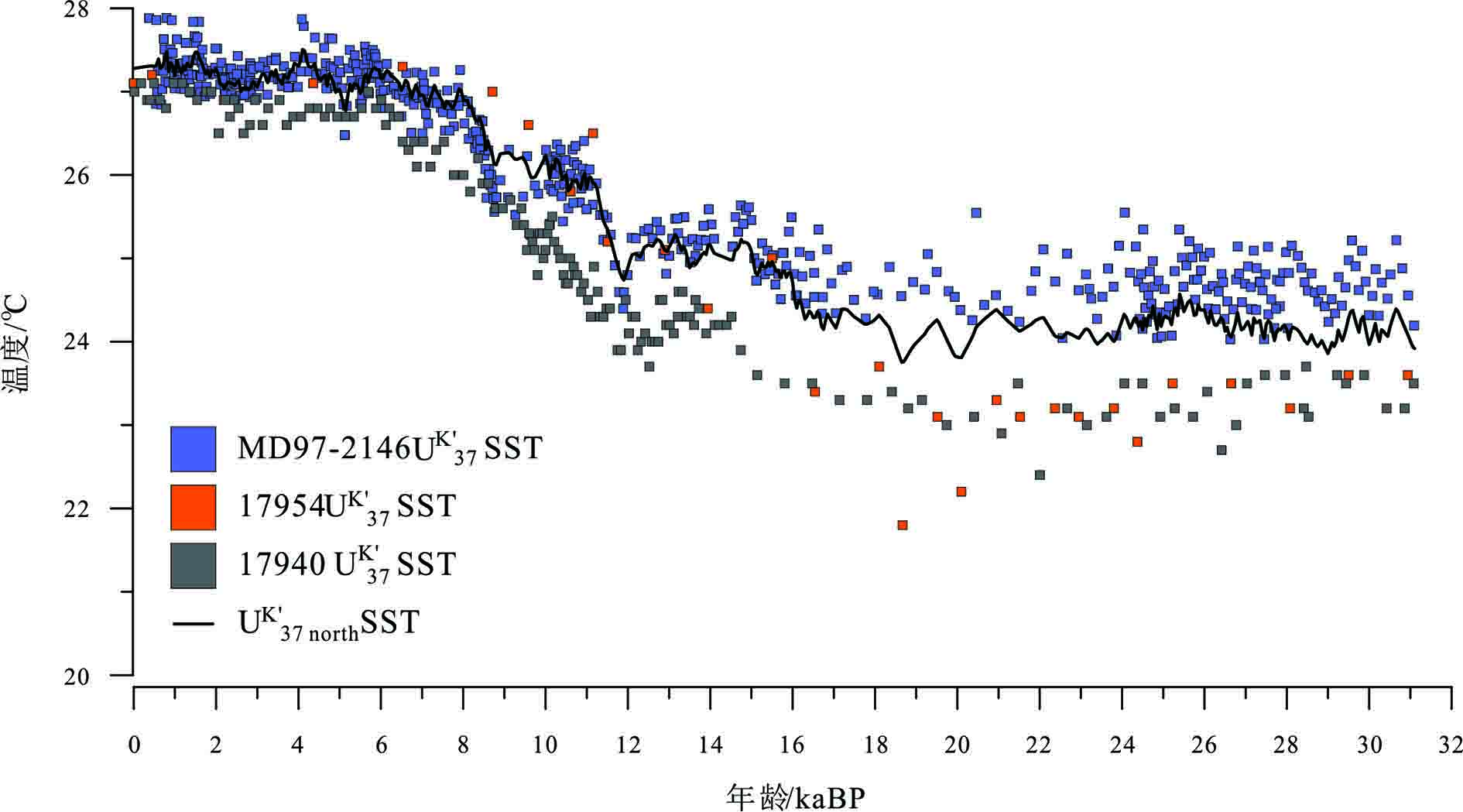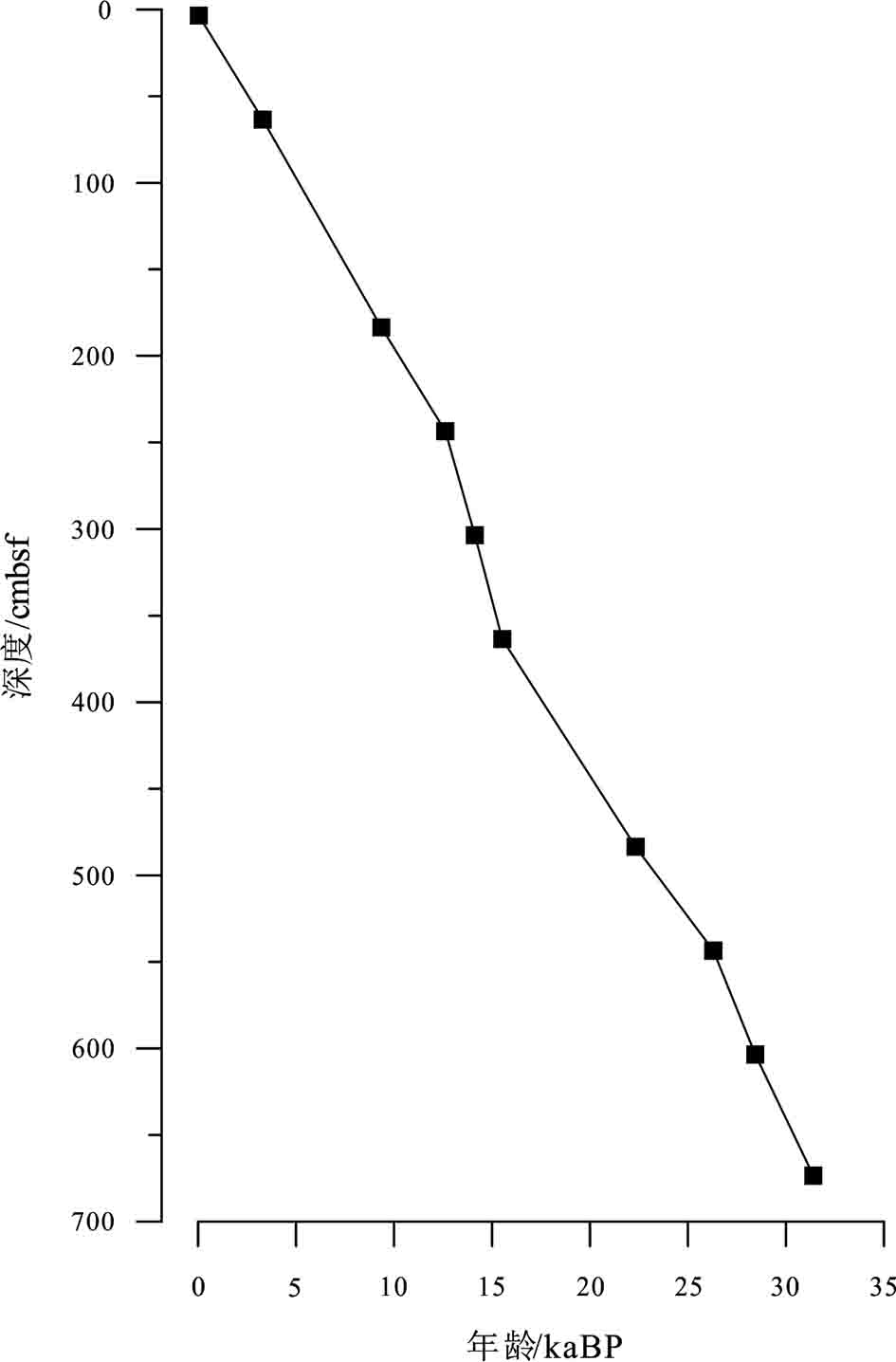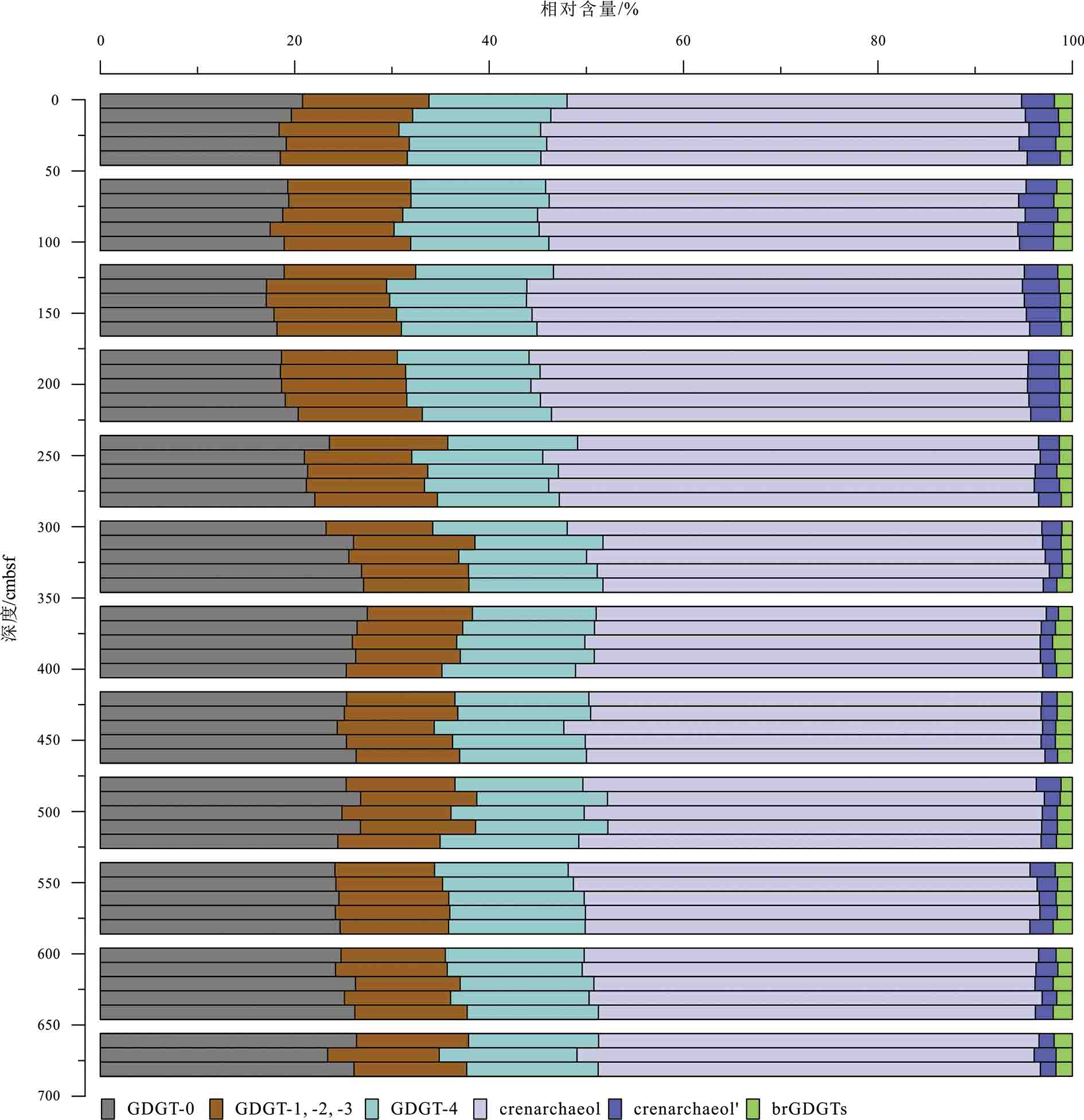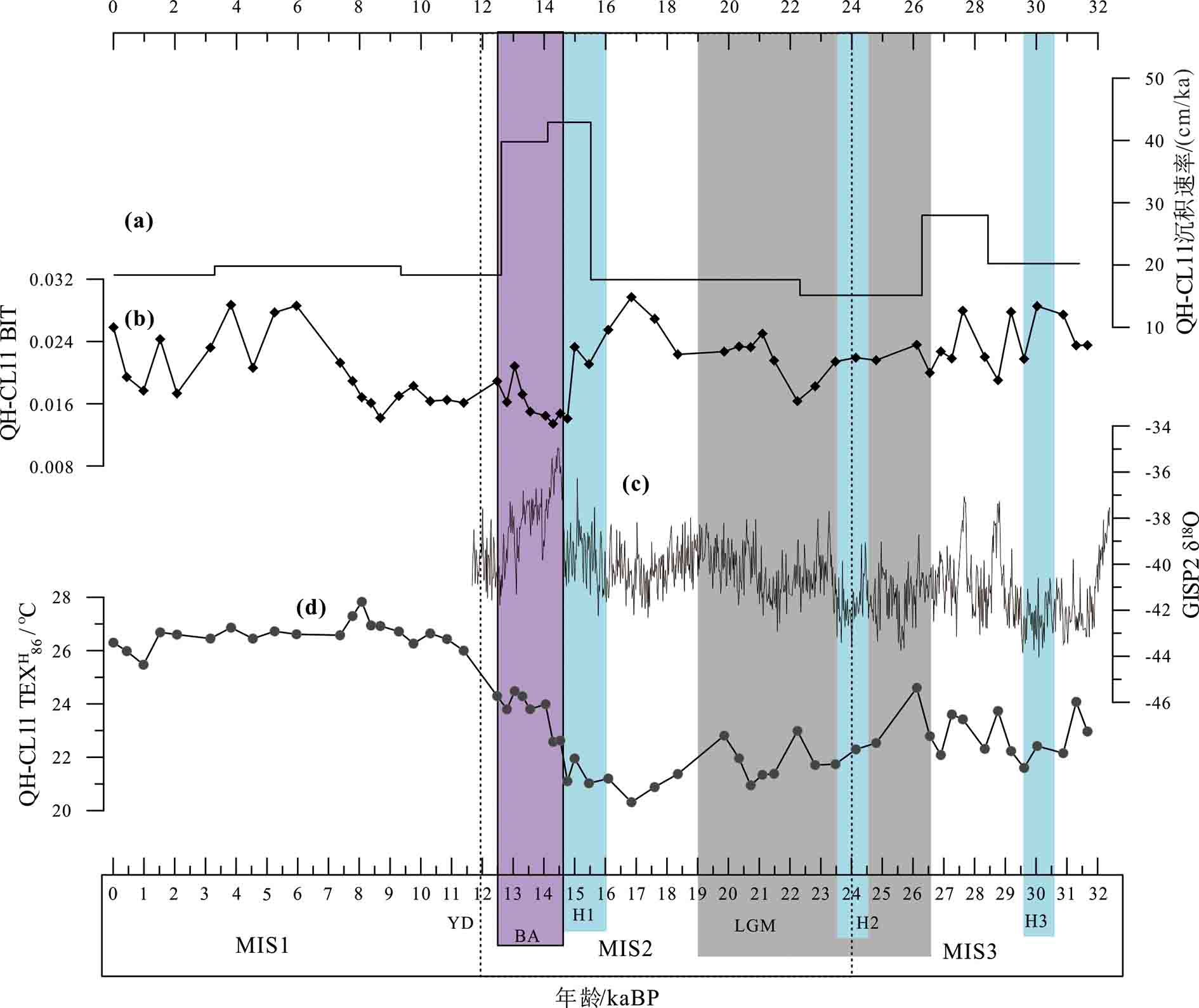Composition of glycerol dibiphytanyl glycerol tetraethers (GDGTs) and its responses to paleotemperature and monsoon changes since 31ka in northern South China Sea
-
摘要:
南海因受到高纬度气候、低纬度大洋以及东亚季风等多种因素的影响而成为研究古温度和季风变化的理想区域。本文通过研究QH-CL11柱状沉积物的GDGTs组成、含量变化特征及其延伸的86个碳原子的四醚指标(TEXH86),分析南海北部GDGTs来源,并定量计算QH-CL11柱状沉积物记录的海洋表面温度(SST),从而探讨31 ka以来南海北部古温度变化的驱动机制。通过甲烷指数和支链/异戊二烯类指标等,确定isoGDGTs主要来自于奇古菌,适用于古温度重建。TEXH86温度显示出明显的冰期—间冰期旋回,与南海北部有孔虫和UK’37 SSTs具有很好的相似性。出现在TEXH86 SST中的海因里希冷事件(H1-3)和Bølling–Allerød暖期之前的温度大幅度上升事件(14.6 ka)反映了高纬度气候对南海的影响。南海SSTs和北太平洋MD01-2421 UK’37 SST的差异(ΔSSTs)可以用来反映东亚冬季风强度的变化。ΔSSTs显示东亚冬季风强度在Bølling–Allerød暖期前增加,在新仙女木时期达到最大值,在全新世早期再次下降,然后在全新世中晚期缓慢增加,这与前人对东亚冬季风强度的认识具有很好的一致性。该方法对重建长周期东亚冬季风强度具有重要的指导意义。
-
关键词:
- 异戊二烯甘油二烷基甘油四醚类 /
- TEXH86 /
- 海洋表面温度 /
- 东亚冬季风强度 /
- 南海北部
Abstract:The South China Sea (SCS), under the control of multiple climate patterns, is an ideal region for studies of paleo-climate and the East Asian monsoon. In this paper, we studied the composition and characteristics of isoGDGTs to further identify their sources and used the outspread TEXH86 index to reconstruct the sea surface temperature (SST) of the northern SCS for the past 31 ka quantificationally. By calculating the Methane Index and BIT indexes, we found that the isoGDGTs mainly came from Thaumarchaeota, and are suitable for TEXH86 appliance. TEXH86 temperatures exhibit distinct glacial–interglacial cycles, and is very similar to the SSTs from foraminifera and UK'37 in the northern SCS. TEXH86 SSTs showed a decline trend during the Heinrich events (H1-3) and an abrupt rise at 14.6 kaBP before Bølling–Allerød (BA) warming, suggesting a tight climate teleconnection between the northern SCS and the North Atlantic region in last Deglaciation. The SST differences (ΔSSTs) between the SCS and the core MD01-2421 in the North Pacific was calculated and used to reveal the intensity of East Asian Winter monsoon. ΔSSTs showed that the EAWM intensity firstly increased before the BA warming, reached a maximum in the Younger Dryas period, decreased again in early Holocene and slowly increased in Late and Middle Holocene. The ∆SSTs results coincide with previous findings on the EAWM variations and constitute a feasible means of long-term EAWM intensity reconstruction.
-

-
图 1 南海北部QH-CL11沉积柱及对比站位位置图[11]
Figure 1.
图 5 (a)南海北部UK’37 north SST和(b)QH-CL11 TEXH86温度,以及(c)UK’37 north SST与QH-CL11 TEXH86温度之间的差值 (夏季、冬季及年平均SST来自19740站位的有孔虫数据[16])
Figure 5.
图 7 (a)QH-CL11的沉积速率,(b)QH-CL11的支链/异戊二烯指标BIT,(c)GISP2冰心δ18O记录[46],(d)QH-CL11 TEXH86 SST
Figure 7.
表 1 文中用到的指标的定义式
Table 1. Initial definitions of the proxies used in this article.
表 2 研究区年平均及季节变化海温数据
Table 2. Annual mean and seasonal SST data in the study area
冬季温度/
℃春季温度/
℃夏季温度/
℃秋季温度/
℃年平均温度/
℃24.3 26.7 29.1 27.5 26.9 注:所有数据都是在0 m水深观测,数据来源于World Ocean Atlas 2013。 表 3 南海北部QH-CL11沉积柱有孔虫AMS14C年龄
Table 3. 14C-AMS ages from core QH-CL11 in the northern South China Sea(SCS)
实验室编号 深度/(cmbsf a) 有孔虫种类 14C测定年龄/aBP 校正后年龄/aBP 526367 2~5 G.ruber + G.sacculifer 200 ±30 0~71 524755 62~65 G.ruber + G.sacculifer 3 450 ±30 3 174~3 426 526368 182~185 G.ruber + G.sacculifer 8 710 ±30 92 43~9 469 524758 242~245 G.ruber + G.sacculifer 11 100 ±30 12 530~12 710 524759 302~305 G.ruber + G.sacculifer 12 650±30 13 950~14 305 524760 362~365 G.ruber + G.sacculifer 13 410±30 15 745~15 306 526370 482~485 G.ruber + G.sacculifer 18 890±60 22 132~22 523 526371 542~545 G.ruber + G.sacculifer 22 500±70 26 045~26 543 526372 602~605 G.ruber + G.sacculifer 24 820±90 28 160~28 715 524765 672~675 G.ruber + G.sacculifer 28 080±120 31 160~31 649 注:a 海底以下以厘米为单位的深度。 表 4 文中收集的古温度和古环境数据来源与信息
Table 4. Sources of paleotemperature and paleoenvironment data collected in the paper
表 5 南海北部QH-CL11柱状沉积物中各指标及TEXH86 SST数据
Table 5. The indices used to evaluate the application of TEX86 and TEXH86 SST in core QH-CL11
编号 深度/
cmbsf年龄/
ka甲烷指数MI GDGT-0/
CrenarchaeolGDGT-2/
Crenarchaeol%GDGT-2 BIT TEXH86 TEXH86 SST/
℃190438 1 0.01 0.21 0.44 0.14 39.8 0.026 −0.180 26.3 190439 11 0.44 0.19 0.40 0.12 38.2 0.019 −0.184 26.0 190440 21 0.99 0.19 0.37 0.12 37.8 0.018 −0.192 25.5 190441 31 1.53 0.19 0.39 0.13 38.4 0.024 −0.174 26.7 190442 41 2.08 0.20 0.37 0.13 40.5 0.017 −0.175 26.6 190443 61 3.16 0.19 0.39 0.13 40.8 0.023 −0.178 26.5 190444 71 3.83 0.20 0.40 0.13 39.8 0.029 −0.172 26.9 190445 81 4.54 0.19 0.37 0.12 39.7 0.021 −0.178 26.5 190446 91 5.25 0.19 0.35 0.13 38.9 0.028 −0.174 26.7 190447 101 5.96 0.20 0.39 0.14 39.9 0.029 −0.175 26.6 190448 121 7.38 0.21 0.39 0.14 40.8 0.021 −0.176 26.6 190449 131 7.78 0.18 0.34 0.12 39.4 0.019 −0.165 27.3 190450 141 8.08 0.19 0.33 0.13 41.3 0.017 −0.157 27.8 190451 151 8.39 0.19 0.35 0.13 39.9 0.016 −0.170 26.9 190452 161 8.69 0.19 0.36 0.13 41.0 0.014 −0.171 26.9 190453 181 9.29 0.18 0.36 0.12 40.2 0.017 −0.174 26.7 190454 191 9.76 0.19 0.37 0.13 40.2 0.018 −0.180 26.3 190455 201 10.31 0.19 0.36 0.13 40.8 0.016 −0.175 26.6 190456 211 10.85 0.19 0.38 0.13 40.3 0.016 −0.178 26.4 190457 221 11.40 0.20 0.41 0.13 40.7 0.016 −0.184 26.0 190458 241 12.48 0.20 0.50 0.12 41.4 0.019 −0.209 24.3 190459 251 12.80 0.17 0.41 0.10 38.7 0.016 −0.216 23.8 190460 261 13.05 0.19 0.43 0.12 40.5 0.021 −0.206 24.5 190461 271 13.30 0.19 0.42 0.11 38.7 0.017 −0.209 24.3 190462 281 13.56 0.20 0.45 0.12 39.5 0.015 −0.216 23.8 190463 301 14.06 0.18 0.48 0.11 39.9 0.014 −0.214 24.0 190464 311 14.30 0.21 0.58 0.13 39.9 0.013 −0.234 22.6 190465 321 14.54 0.19 0.54 0.11 39.4 0.015 −0.234 22.6 190466 331 14.77 0.19 0.58 0.10 39.0 0.014 −0.256 21.1 190467 341 15.00 0.19 0.60 0.11 39.8 0.023 −0.243 22.0 190468 361 15.47 0.19 0.59 0.10 39.3 0.021 −0.257 21.0 190469 371 16.09 0.19 0.57 0.10 37.7 0.025 −0.254 21.2 190470 381 16.85 0.18 0.55 0.10 37.6 0.030 −0.267 20.3 190471 391 17.60 0.18 0.57 0.10 36.9 0.027 −0.259 20.9 190472 401 18.36 0.17 0.53 0.09 36.4 0.022 −0.252 21.4 190473 421 19.86 0.19 0.54 0.11 40.3 0.023 −0.231 22.8 190474 431 20.34 0.20 0.54 0.11 39.1 0.023 −0.243 22.0 190475 441 20.72 0.16 0.49 0.08 36.9 0.023 −0.258 20.9 190476 451 21.10 0.18 0.54 0.10 37.9 0.025 −0.252 21.3 190477 461 21.48 0.18 0.56 0.10 39.1 0.022 −0.252 21.4 190478 481 22.24 0.19 0.54 0.10 35.2 0.016 −0.228 23.0 190479 491 22.82 0.20 0.60 0.12 38.7 0.018 −0.247 21.7 190480 501 23.48 0.19 0.53 0.10 38.4 0.021 −0.246 21.7 190481 511 24.14 0.20 0.60 0.12 39.6 0.022 −0.238 22.3 190482 521 24.80 0.18 0.51 0.10 38.2 0.022 −0.235 22.5 190483 541 26.12 0.17 0.51 0.10 36.0 0.024 −0.205 24.6 190484 551 26.55 0.18 0.51 0.10 36.0 0.020 −0.231 22.8 190485 561 26.91 0.19 0.52 0.11 37.8 0.023 −0.241 22.1 190486 571 27.26 0.20 0.52 0.12 40.7 0.022 −0.219 23.6 190487 581 27.62 0.19 0.54 0.11 36.4 0.028 −0.222 23.4 190488 601 28.33 0.18 0.53 0.10 36.2 0.022 −0.238 22.3 190489 611 28.76 0.19 0.52 0.11 38.2 0.019 −0.217 23.7 190490 621 29.19 0.19 0.58 0.10 36.4 0.028 −0.239 22.2 190491 631 29.61 0.19 0.54 0.10 37.4 0.022 −0.249 21.6 190492 641 30.04 0.20 0.58 0.11 38.0 0.029 −0.237 22.4 190493 661 30.88 0.20 0.58 0.11 39.1 0.027 −0.240 22.2 190494 671 31.31 0.19 0.50 0.11 38.3 0.024 −0.212 24.1 190495 681 31.67 0.20 0.57 0.12 40.4 0.024 −0.229 23.0 -
[1] Lau K M, Kim M K, Kim K M. Asian summer monsoon anomalies induced by aerosol direct forcing: the role of the Tibetan Plateau [J]. Climate Dynamics, 2006, 26(7-8): 855-864. doi: 10.1007/s00382-006-0114-z
[2] Dykoski C A, Edwards R L, Cheng H, et al. A high-resolution, absolute-dated Holocene and deglacial Asian monsoon record from Dongge Cave, China [J]. Earth and Planetary Science Letters, 2005, 233(1-2): 71-86. doi: 10.1016/j.jpgl.2005.01.036
[3] Wang Y J, Cheng H, Edwards R L, et al. The Holocene Asian monsoon: links to solar changes and North Atlantic climate [J]. Science, 2005, 308(5723): 854-857. doi: 10.1126/science.1106296
[4] Wang Y J, Cheng H, Edwards R L, et al. A high-resolution absolute-dated Late Pleistocene monsoon record from Hulu Cave, China [J]. Science, 2001, 294(5550): 2345-2348. doi: 10.1126/science.1064618
[5] Yancheva G, Nowaczyk N R, Mingram J, et al. Influence of the intertropical convergence zone on the East Asian monsoon [J]. Nature, 2007, 445(7123): 74-77. doi: 10.1038/nature05431
[6] 李明坤. 南海西北部36 kyr BP以来的古气候环境演变与驱动机制[D]. 中国科学院大学(中国科学院广州地球化学研究所)博士学位论文, 2018.
LI Mingkun. Paleocliamte and paleoenvironment evolutions in the Northwestern South China Sea over the past 36 kyr BP and the forcing mechanisms[D]. Doctor Dissertation of University of Chinese Academy of Sciences (Guangzhou Institute of geochemistry, Chinese Academy of Sciences), 2018.
[7] Liu J B, Chen J H, Zhang X J, et al. Holocene East Asian summer monsoon records in northern China and their inconsistency with Chinese stalagmite δ18O records [J]. Earth-Science Reviews, 2015, 148: 194-208. doi: 10.1016/j.earscirev.2015.06.004
[8] 许慎栋, 陈文煌, 邓文峰, 等. 南海北部沉积物中浮游有孔虫Globigerinoides ruber壳体氧同位素指示的冬季表层海水温度[J]. 海洋地质与第四纪地质, 2016, 36(2):101-107
XU Shendong, CHEN Wenhuang, DENG Wenfeng, et al. Winter surface seawater temperature in the northern South China Sea induced from temperature index of shell oxygen isotope of Globigerinoides ruber [J]. Marine Geology & Quaternary Geology, 2016, 36(2): 101-107.
[9] Lin D C, Chen M T, Yamamoto M, et al. Millennial-scale alkenone sea surface temperature changes in the northern South China Sea during the past 45, 000 years (MD972146) [J]. Quaternary International, 2014, 333: 207-215. doi: 10.1016/j.quaint.2014.03.062
[10] Yamamoto M, Sai H, Chen M T, et al. The East Asian winter monsoon variability in response to precession during the past 150 000 yr [J]. Climate of the Past, 2013, 9(6): 2777-2788. doi: 10.5194/cp-9-2777-2013
[11] Li D W, Zhao M X, Tian J, et al. Comparison and implication of TEX86 and U-37K' temperature records over the last 356 kyr of ODP Site 1147 from the northern South China Sea [J]. Palaeogeography, Palaeoclimatology, Palaeoecology, 2013, 376: 213-223.
[12] Shintani T, Yamamoto M, Chen M T. Paleoenvironmental changes in the northern South China Sea over the past 28, 000 years: A study of TEX86-derived sea surface temperatures and terrestrial biomarkers [J]. Journal of Asian Earth Sciences, 2011, 40(6): 1221-1229. doi: 10.1016/j.jseaes.2010.09.013
[13] Huang E Q, Tian J, Steinke S. Millennial-scale dynamics of the winter cold tongue in the southern South China Sea over the past 26 ka and the East Asian winter monsoon [J]. Quaternary Research, 2011, 75(1): 196-204. doi: 10.1016/j.yqres.2010.08.014
[14] Li L, Wang H, Li J R, et al. Changes in sea surface temperature in western South China Sea over the past 450 ka [J]. Chinese Science Bulletin, 2009, 54(18): 3335-3343. doi: 10.1007/s11434-009-0083-9
[15] Shintani T, Yamamoto M, Chen M T. Slow warming of the northern South China Sea during the last deglaciation [J]. Terrestrial Atmospheric and Oceanic Sciences, 2008, 19(4): 341-346. doi: 10.3319/TAO.2008.19.4.341(IMAGES)
[16] Wang L, Sarnthein M, Erlenkeuser H, et al. East Asian monsoon climate during the Late Pleistocene: high-resolution sediment records from the south China Sea [J]. Marine Geology, 1999, 156(1-4): 245-284. doi: 10.1016/S0025-3227(98)00182-0
[17] Pelejero C, Grimalt J O, Heilig S, et al. High-resolution UK37 temperature reconstructions in the South China Sea over the past 220 kyr [J]. Paleoceanography and Paleoclimatology, 1999, 14(2): 224-231.
[18] Huang C Y, Liew P M, Zhao M X, et al. Deep sea and lake records of the Southeast Asian paleomonsoons for the last 25 thousand years [J]. Earth and Planetary Science Letters, 1997, 146(1-2): 59-72. doi: 10.1016/S0012-821X(96)00203-8
[19] 王小华, 陈荣华, 赵庆英, 等. 2009—2010年南海北部浮游有孔虫通量和稳定同位素季节变化及其对东亚季风的响应[J]. 海洋地质与第四纪地质, 2014, 34(1):103-115
WANG Xiaohua, CHEN Ronghua, ZHAO Qingying, et al. The influence of East Asian Monsoon on seasonal variations in planktonic foraminiferal flux and stable isotope in the northern South China Sea during 2009-2010 [J]. Marine Geology & Quaternary Geology, 2014, 34(1): 103-115.
[20] Liu Q Y, Jiang X, Xie S P, et al. A gap in the Indo-Pacific warm pool over the South China Sea in boreal winter: Seasonal development and interannual variability [J]. Journal of Geophysical Research: Oceans, 2004, 109(C7): C07012.
[21] Koutavas A, Lynch-Stieglitz J, Marchitto T M Jr, et al. El Nino-like pattern in ice age tropical Pacific sea surface temperature [J]. Science, 2002, 297(5579): 226-230. doi: 10.1126/science.1072376
[22] Wang P X, Wang L J, Bian Y H, et al. Late quaternary paleoceanography of the South China Sea: surface circulation and carbonate cycles [J]. Marine Geology, 1995, 127(1-4): 145-165. doi: 10.1016/0025-3227(95)00008-M
[23] Wang L J, Wang P X. Late quaternary paleoceanography of the South China Sea: glacial-interglacial contrasts in an enclosed basin [J]. Paleoceanography and Paleoclimatology, 1990, 5(1): 77-90.
[24] Wei G J, Li X H, Nie B F, et al. High resolution Porites Mg/Ca thermometer for the north of the South China Sea [J]. Chinese Science Bulletin, 1999, 44(3): 273-276. doi: 10.1007/BF02896292
[25] Lin D C, Chen M T, Yamamoto M, et al. Hydrographic variability in the northern South China Sea over the past 45, 000 years: New insights based on temperature reconstructions by Uk’37 and TEXH86 proxies from a marine sediment core (MD972146) [J]. Quaternary International, 2017, 459: 1-16. doi: 10.1016/j.quaint.2017.09.029
[26] Jia G D, Zhang J, Chen J F, et al. Archaeal tetraether lipids record subsurface water temperature in the South China Sea [J]. Organic Geochemistry, 2012, 50: 68-77. doi: 10.1016/j.orggeochem.2012.07.002
[27] Steinke S, Kienast M, Groeneveld J, et al. Proxy dependence of the temporal pattern of deglacial warming in the tropical South China Sea: toward resolving seasonality [J]. Quaternary Science Reviews, 2008, 27(7-8): 688-700. doi: 10.1016/j.quascirev.2007.12.003
[28] Schouten S, Hopmans E C, Schefuß E, et al. Distributional variations in marine crenarchaeotal membrane lipids: a new tool for reconstructing ancient sea water temperatures? [J]. Earth and Planetary Science Letters, 2002, 204(1-2): 265-274. doi: 10.1016/S0012-821X(02)00979-2
[29] Uda I, Sugai A, Itoh Y H, et al. Variation in molecular species of polar lipids from Thermoplasma acidophilum depends on growth temperature [J]. Lipids, 2001, 36(1): 103-105. doi: 10.1007/s11745-001-0914-2
[30] Gliozzi A, Paoli G, De Rosa M, et al. Effect of isoprenoid cyclization on the transition temperature of lipids in thermophilic archaebacteria [J]. Biochimica et Biophysica Acta (BBA)-Biomembranes, 1983, 735(2): 234-242. doi: 10.1016/0005-2736(83)90298-5
[31] Wuchter C, Schouten S, Coolen M J L, et al. Temperature-dependent variation in the distribution of tetraether membrane lipids of marine Crenarchaeota: Implications for TEX86 paleothermometry [J]. Paleoceanography and Paleoclimatology, 2004, 19(4): PA4028.
[32] Kim J H, Van Der Meer J, Schouten S, et al. New indices and calibrations derived from the distribution of crenarchaeal isoprenoid tetraether lipids: Implications for past sea surface temperature reconstructions [J]. Geochimica et Cosmochimica Acta, 2010, 74(16): 4639-4654. doi: 10.1016/j.gca.2010.05.027
[33] Pelejero C, Grimalt J O. The correlation between the U37k index and sea surface temperatures in the warm boundary: The South China Sea [J]. Geochimica et Cosmochimica Acta, 1997, 61(22): 4789-4797. doi: 10.1016/S0016-7037(97)00280-9
[34] Wei Y L, Wang J X, Liu J, et al. Spatial variations in archaeal lipids of surface water and core-top sediments in the south china sea and their implications for paleoclimate studies [J]. Applied and Environmental Microbiology, 2011, 77(21): 7479-7489. doi: 10.1128/AEM.00580-11
[35] Zhang J, Bai Y, Xu S D, et al. Alkenone and tetraether lipids reflect different seasonal seawater temperatures in the coastal northern South China Sea [J]. Organic Geochemistry, 2013, 58: 115-120. doi: 10.1016/j.orggeochem.2013.02.012
[36] Hopmans E C, Weijers J W H, Schefuß E, et al. A novel proxy for terrestrial organic matter in sediments based on branched and isoprenoid tetraether lipids [J]. Earth and Planetary Science Letters, 2004, 224(1-2): 107-116. doi: 10.1016/j.jpgl.2004.05.012
[37] Zhang Y G, Zhang C L, Liu X L, et al. Methane Index: A tetraether archaeal lipid biomarker indicator for detecting the instability of marine gas hydrates [J]. Earth and Planetary Science Letters, 2011, 307(3-4): 525-534. doi: 10.1016/j.jpgl.2011.05.031
[38] Damsté J S S, Ossebaar J, Schouten S, et al. Distribution of tetraether lipids in the 25-ka sedimentary record of Lake Challa: extracting reliable TEX86 and MBT/CBT palaeotemperatures from an equatorial African lake [J]. Quaternary Science Reviews, 2012, 50: 43-54. doi: 10.1016/j.quascirev.2012.07.001
[39] Weijers J W H, Lim K L H, Aquilina A, et al. Biogeochemical controls on glycerol dialkyl glycerol tetraether lipid distributions in sediments characterized by diffusive methane flux [J]. Geochemistry, Geophysics, Geosystems, 2011, 12(10): Q10010. doi: 10.1029/2011GC003724
[40] Blaga C I, Reichart G J, Heiri O, et al. Tetraether membrane lipid distributions in water-column particulate matter and sediments: a study of 47 European lakes along a north-south transect [J]. Journal of Paleolimnology, 2009, 41(3): 523-540.
[41] Yeh Y C, Sibuet J C, Hsu S K, et al. Tectonic evolution of the Northeastern South China Sea from seismic interpretation [J]. Journal of Geophysical Research: Solid Earth, 2010, 115(B6): B0610. doi: 10.1029/2009JB006354
[42] Huguet C, Hopmans E C, Febo-Ayala W, et al. An improved method to determine the absolute abundance of glycerol dibiphytanyl glycerol tetraether lipids [J]. Organic Geochemistry, 2006, 37(9): 1036-1041. doi: 10.1016/j.orggeochem.2006.05.008
[43] Hopmans E C, Schouten S, Damsté J S S. The effect of improved chromatography on GDGT-based palaeoproxies [J]. Organic Geochemistry, 2016, 93: 1-6. doi: 10.1016/j.orggeochem.2015.12.006
[44] Müller P J, Kirst G, Ruhland G, et al. Calibration of the alkenone paleotemperature index U37K′ based on core-tops from the eastern South Atlantic and the global ocean (60°N-60°S) [J]. Geochimica et Cosmochimica Acta, 1998, 62(10): 1757-1772.
[45] Prahl F G, Muehlhausen L A, Zahnle D L. Further evaluation of long-chain alkenones as indicators of paleoceanographic conditions [J]. Geochimica et Cosmochimica Acta, 1988, 52(9): 2303-2310. doi: 10.1016/0016-7037(88)90132-9
[46] Rasmussen S O, Seierstad I K, Andersen K K, et al. Synchronization of the NGRIP, GRIP, and GISP2 ice cores across MIS 2 and palaeoclimatic implications [J]. Quaternary Science Reviews, 2008, 27(1-2): 18-28. doi: 10.1016/j.quascirev.2007.01.016
[47] Isono D, Yamamoto M, Irino T, et al. The 1500-year climate oscillation in the midlatitude North Pacific during the Holocene [J]. Geology, 2009, 37(7): 591-594. doi: 10.1130/G25667A.1
[48] Zhao M X, Huang C Y, Wang C C, et al. A millennial-scale U37K′ sea-surface temperature record from the South China Sea (8°N) over the last 150 kyr: Monsoon and sea-level influence [J]. Palaeogeography, Palaeoclimatology, Palaeoecology, 2006, 236(1-2): 39-55. doi: 10.1016/j.palaeo.2005.11.033
[49] Reimer P J, Bard E, Bayliss A, et al. IntCal13 and Marine13 radiocarbon age calibration curves 0-50,000 years cal BP [J]. Radiocarbon, 2013, 55(4): 1869-1887. doi: 10.2458/azu_js_rc.55.16947
[50] Wuchter C, Schouten S, Wakeham S G, et al. Temporal and spatial variation in tetraether membrane lipids of marine Crenarchaeota in particulate organic matter: Implications for TEX86 paleothermometry [J]. Paleoceanography and Paleoclimatology, 2005, 20(3): PA3013.
[51] Massana R, Murray A E, Preston C M, et al. Vertical distribution and phylogenetic characterization of marine planktonic Archaea in the Santa Barbara Channel [J]. Applied and Environmental Microbiology, 1997, 63(1): 50-56. doi: 10.1128/AEM.63.1.50-56.1997
[52] Zhang C Y, Hu C M, Shang S L, et al. Bridging between SeaWiFS and MODIS for continuity of chlorophyll-a concentration assessments off Southeastern China [J]. Remote Sensing of Environment, 2006, 102(3-4): 250-263. doi: 10.1016/j.rse.2006.02.015
[53] Yamamoto M, Shimamoto A, Fukuhara T, et al. Glycerol dialkyl glycerol tetraethers and TEX86 index in sinking particles in the western North Pacific [J]. Organic Geochemistry, 2012, 53: 52-62.
[54] Fallet U, Ullgren J E, Castañeda I S, et al. Contrasting variability in foraminiferal and organic paleotemperature proxies in sedimenting particles of the Mozambique Channel (SW Indian Ocean) [J]. Geochimica et Cosmochimica Acta, 2011, 75(20): 5834-5848. doi: 10.1016/j.gca.2011.08.009
[55] Wuchter C, Schouten S, Wakeham S G, et al. Archaeal tetraether membrane lipid fluxes in the northeastern Pacific and the Arabian Sea: Implications for TEX86 paleothermometry [J]. Paleoceanography and Paleoclimatology, 2006, 21(4): PA4208.
[56] Zhang Y G, Liu X Q. Export depth of the TEX86 signal [J]. Paleoceanography and Paleoclimatology, 2018, 33(7): 666-671. doi: 10.1029/2018PA003337
[57] Schouten S, Hopmans E C, Damsté J S S. The organic geochemistry of glycerol dialkyl glycerol tetraether lipids: A review [J]. Organic Geochemistry, 2013, 54: 19-61. doi: 10.1016/j.orggeochem.2012.09.006
[58] Thompson P R. Planktonic foraminifera in the Western North Pacific during the past 150 000 years: Comparison of modern and fossil assemblages [J]. Palaeogeography, Palaeoclimatology, Palaeoecology, 1981, 35: 241-279. doi: 10.1016/0031-0182(81)90099-7
[59] Kienast M, Steinke S, Stattegger K, et al. Synchronous tropical South China Sea SST change and Greenland warming during deglaciation [J]. Science, 2001, 291(5511): 2132-2134. doi: 10.1126/science.1057131
[60] Bard E, Rostek F, Sonzogni C. Interhemispheric synchrony of the last deglaciation inferred from alkenone palaeothermometry [J]. Nature, 1997, 385(6618): 707-710. doi: 10.1038/385707a0
[61] Bond G C, Lotti R. Iceberg discharges into the north atlantic on millennial time scales during the last glaciation [J]. Science, 1995, 267(5200): 1005-1010.
[62] Bond G C, Heinrich H, Broecker W, et al. Evidence for massive discharges of icebergs into the North Atlantic ocean during the last glacial period [J]. Nature, 1992, 360(6401): 245-249. doi: 10.1038/360245a0
[63] Zhang R, Delworth T L. Simulated tropical response to a substantial weakening of the Atlantic thermohaline circulation [J]. Journal of Climate, 2005, 18(12): 1853-1860. doi: 10.1175/JCLI3460.1
[64] Claussen M, Ganopolski A, Brovkin V, et al. Simulated global-scale response of the climate system to Dansgaard/Oeschger and Heinrich events [J]. Climate Dynamics, 2003, 21(5-6): 361-370. doi: 10.1007/s00382-003-0336-2
[65] Leuschner D C, Sirocko F. The low-latitude monsoon climate during Dansgaard-Oeschger cycles and Heinrich Events [J]. Quaternary Science Reviews, 2000, 19(1-5): 243-254.
[66] Schulz H, Von Rad U, Erlenkeuser H, et al. Correlation between Arabian Sea and Greenland climate oscillations of the past 110, 000 years [J]. Nature, 1998, 393(6680): 54-57. doi: 10.1038/31750
[67] Berger A, Loutre M F. Insolation values for the climate of the last 10 million years [J]. Quaternary Science Reviews, 1991, 10(4): 297-317. doi: 10.1016/0277-3791(91)90033-Q
-




 下载:
下载:












